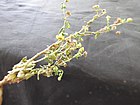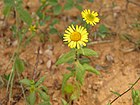Note: This is a project under development. The articles on this wiki are just being initiated and broadly incomplete. You can Help creating new pages.
Vicoa indica
White dammar is a large, evergreen tree generally growing up to 40 metres tall, but with some specimens reaching 60 metres. A multipurpose tree that is much used locally in India. It yields a resin of considerable value, which is known as White Dammar or Piney, and is often exported.
Contents
[hide]- 1 Uses
- 2 Parts Used
- 3 Chemical Composition
- 4 Common names
- 5 Properties
- 6 Habit
- 7 Identification
- 8 List of Ayurvedic medicine in which the herb is used
- 9 Where to get the saplings
- 10 Mode of Propagation
- 11 How to plant/cultivate
- 12 Commonly seen growing in areas
- 13 Photo Gallery
- 14 References
- 15 External Links
Uses
Resin, Rheumatism, Scorpion bite, Sore throat.[1]
Parts Used
Chemical Composition
The preliminary phytochemical studies were carried out by the methods described by Harborne and Kokate. The plant extracts were screened for the presence of alkaloids, proteins, free amino acids, anthraquinones glycosides, flavonoids, tannins, phenolic compounds, carbohydrates, saponins, phytosterol and triterpenes.[3]
Common names
| Language | Common name |
|---|---|
| Kannada | Moogatisoppu |
| Hindi | |
| Malayalam | |
| Tamil | Mukuttipundu |
| Telugu | Adavipundu tirugadu |
| Marathi | |
| Gujarathi | |
| Punjabi | |
| Kashmiri | |
| Sanskrit | |
| English | Sonkadi |
Properties
Reference: Dravya - Substance, Rasa - Taste, Guna - Qualities, Veerya - Potency, Vipaka - Post-digesion effect, Karma - Pharmacological activity, Prabhava - Therepeutics.
Dravya
Rasa
Guna
Veerya
Vipaka
Karma
Prabhava
Habit
Identification
Leaf
| Kind | Shape | Feature |
|---|---|---|
| Alternately arranged | Oblong lancelike | Stalkless, 3-8cm long and hairy |
Flower
| Type | Size | Color and composition | Stamen | More information |
|---|---|---|---|---|
| 1-2cm across | Yellow | Occur singly on slender stalks, ray florets | Flowering season is February - April |
Fruit
| Type | Size | Mass | Appearance | Seeds | More information |
|---|---|---|---|---|---|
| Fruiting season is February - April |
Other features
List of Ayurvedic medicine in which the herb is used
Where to get the saplings
Mode of Propagation
How to plant/cultivate
A tree of low to moderate elevations in the moist, monsoonal tropics, where it can be found at elevations up to 1,200 metres.[5]
Commonly seen growing in areas
Found primarily as a canopy or emergent tree in the west coastal evergreen forests of India, It is also occasionally found in secondary evergreen dipterocarp forest in the south.
Photo Gallery
References
- Jump up ↑ Indian Medicinal Plants by C.P.Khare
- ↑ Jump up to: 2.0 2.1 "Karnataka Medicinal Plants Volume - 2" by Dr.M. R. Gurudeva, Page No.580, Published by Divyachandra Prakashana, #45, Paapannana Tota, 1st Main road, Basaveshwara Nagara, Bengaluru.
- Jump up ↑ Chemical constituents
- Jump up ↑ Kappatagudda - A Repertoire of Medicianal Plants of Gadag by Yashpal Kshirasagar and Sonal Vrishni, Page No. 384
- Jump up ↑ [Cultivation]
External Links
- Ayurvedic Herbs known to be helpful to treat Resin
- Ayurvedic Herbs known to be helpful to treat Rheumatism
- Ayurvedic Herbs known to be helpful to treat Scorpion bite
- Ayurvedic Herbs known to be helpful to treat Sore throat
- Herbs with Root used in medicine
- Herbs with Flower used in medicine
- Herbs with common name in Kannada
- Herbs with common name in Tamil
- Herbs with common name in Telugu
- Herbs with common name in English
- Habit - Evergreen tree
- Index of Plants which can be propagated by Seeds
- Herbs that are commonly seen in the region of Found primarily as a canopy or emergent tree in the west coastal evergreen forests of India
- Herbs that are commonly seen in the region of It is also occasionally found in secondary evergreen dipterocarp forest in the south
- Herbs



